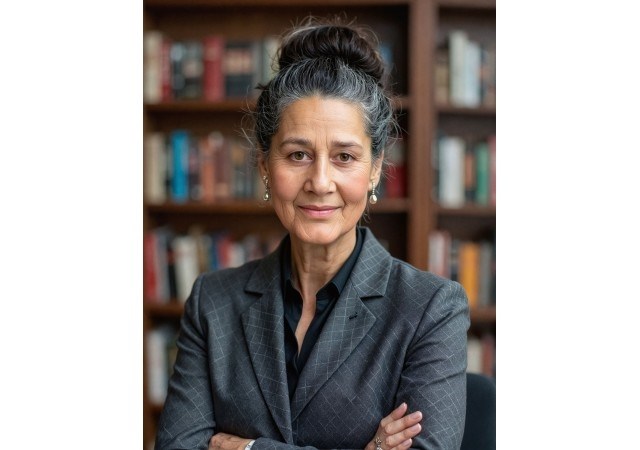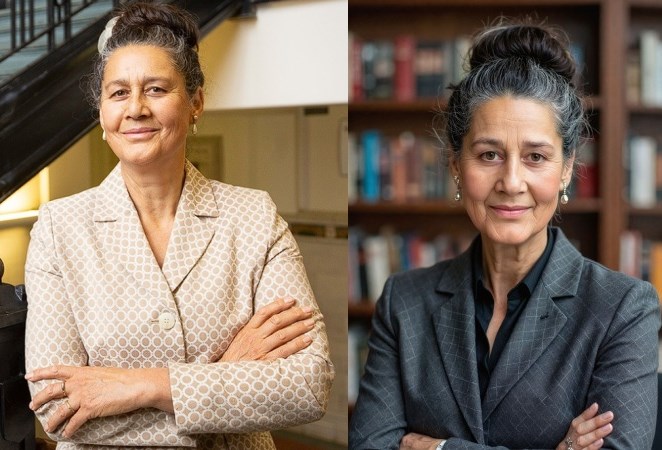
Thompson Rivers University provided this AI-generated image of its next president, Dr. Airini, in an April 2, 2025 news release.
Image Credit: SUBMITTED/Thompson Rivers University
April 06, 2025 - 4:00 AM
Do you see it?
You may think it's the new president of Thompson Rivers University. In fact, it's a computer's best approximation of her — and it's almost exact.
The uncanny sheen, subtle errors and impossibly perfect complexion of a computer-generated image is becoming more familiar online.
When TRU announced Dr. Airini got the job, a single portrait photograph was included in the news release. On first glance, it may seem correct, but zoom in and the cues of an AI-generated image become clear.
Though AI has quickly become ubiquitous with being online, the university's news release made no mention of the fact it was a fabricated image.
Airini (who goes by one name) was transparent about its creation when asked on April 2, the day her hiring was announced.
"It was really about the time that was available," she said. "I kind of like this because I'm impatient for AI usage to be normal."
Generative AI tools often work with text prompts where a user will describe what they want, and it will use the slew of online information it has to approximate an image. That's not how Airini created hers.
READ MORE: Former Penticton mayor files yet another lawsuit against family members
Unable to get the photographer she wanted in time for a new professional headshot, she inserted several photos she already had to an AI image generator called "Better Pic." Her husband picked out the one that looked most like her.

Dr. Airini is seen in a 2020 photograph (left) and the AI-generated photo (right).
Image Credit: University of Saskatchewan/David Stobbe and SUBMITTED/TRU
Because it was based in part on professional photos she already had, the result was fairly accurate, and she saw the filtered appearance as similar to editing a professional photographer might do.
"My advice... is to get one of those formal sit-ins one might do with a human, then put it with other human-based photos, then allow the tool to do what it's designed to do," she said.
Artificial intelligence seems inescapable online.
Whether it's Spotify's DJ bot or summarized Google search results, many tech companies are pushing overt AI features. Social media, especially Facebook, is inundated with AI-generated images.
Some are obvious, others can be more deceptive and it may not be clear whether the image is real.
READ MORE: Controversial Kelowna pastor steps down amid abuse allegations
Whether it impacts on privacy, job efficiency, art, misinformation, transparency or copyright infringement, AI is rapidly becoming a reality in a hyper-connected world. As it becomes more commonplace companies, governments, industries and academics have steadily incorporated policies alongside the burgeoning technology.
TRU is one of those places.
One condition that's generally consistent wherever AI is accepted is transparent disclosure of its use. In this case, that didn't happen.
The school's own guidance for students is clear: if a professor allows AI, the student should clearly acknowledge how it was used. It's a rule for any academic journal, provided they allow for AI at all.
Many schools have come up with policies to work with the technology instead of trying to stop the inevitable temptation for students, while more have turned to AI as an easy cheating method, seen recently at the University of Fraser Valley.
Most news agencies, meanwhile, have avoided its use for publishable content, especially for photos. The industry has generally avoided editing photos at all, and The Canadian Press won't use AI to fabricate entirely new images. If they are used, it's because the AI image is a subject of the story itself and must be clearly identified as computer-generated, much like in academia.
Asked about disclosing the image's source, she said the TRU communications department said it's "not standard practice."
It's also impressively accurate to her actual appearance.
"Is the public being deceived? Do I actually look like that? ... The answer is I do look like that," Airini said.
Compared with other photographs, there are subtle tells like what appears to be two piercings with one ear ring, a slight change to Airini's face shape and the unmistakable glossy finish of an artificially-generated image.
"Should the source of every photo be disclosed? That's going to be something for the industry to figure out as we get further along with this experience. We're still only months, really, into AI being as it is," TRU's new president said.
To contact a reporter for this story, email Levi Landry or call 250-819-3723 or email the editor. You can also submit photos, videos or news tips to the newsroom and be entered to win a monthly prize draw.
We welcome your comments and opinions on our stories but play nice. We won't censor or delete comments unless they contain off-topic statements or links, unnecessary vulgarity, false facts, spam or obviously fake profiles. If you have any concerns about what you see in comments, email the editor in the link above. SUBSCRIBE to our awesome newsletter here.
News from © iNFOnews, 2025